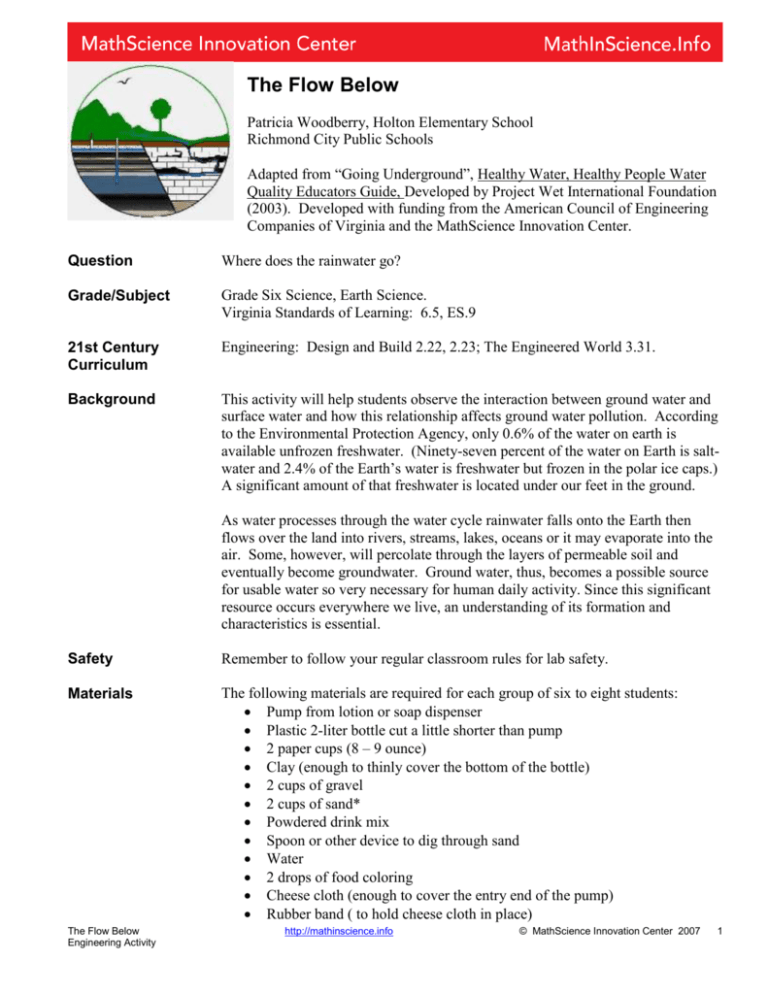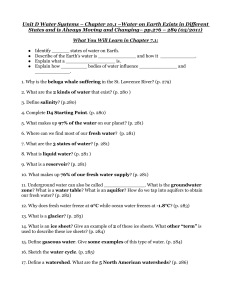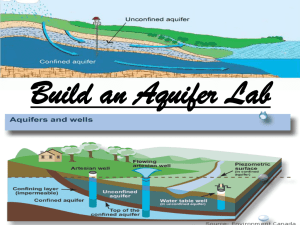TheFlowBelowweb - MathinScience.info
advertisement

The Flow Below Patricia Woodberry, Holton Elementary School Richmond City Public Schools Adapted from “Going Underground”, Healthy Water, Healthy People Water Quality Educators Guide, Developed by Project Wet International Foundation (2003). Developed with funding from the American Council of Engineering Companies of Virginia and the MathScience Innovation Center. Question Where does the rainwater go? Grade/Subject Grade Six Science, Earth Science. Virginia Standards of Learning: 6.5, ES.9 21st Century Curriculum Engineering: Design and Build 2.22, 2.23; The Engineered World 3.31. Background This activity will help students observe the interaction between ground water and surface water and how this relationship affects ground water pollution. According to the Environmental Protection Agency, only 0.6% of the water on earth is available unfrozen freshwater. (Ninety-seven percent of the water on Earth is saltwater and 2.4% of the Earth’s water is freshwater but frozen in the polar ice caps.) A significant amount of that freshwater is located under our feet in the ground. As water processes through the water cycle rainwater falls onto the Earth then flows over the land into rivers, streams, lakes, oceans or it may evaporate into the air. Some, however, will percolate through the layers of permeable soil and eventually become groundwater. Ground water, thus, becomes a possible source for usable water so very necessary for human daily activity. Since this significant resource occurs everywhere we live, an understanding of its formation and characteristics is essential. Safety Remember to follow your regular classroom rules for lab safety. Materials The following materials are required for each group of six to eight students: Pump from lotion or soap dispenser Plastic 2-liter bottle cut a little shorter than pump 2 paper cups (8 – 9 ounce) Clay (enough to thinly cover the bottom of the bottle) 2 cups of gravel 2 cups of sand* Powdered drink mix Spoon or other device to dig through sand Water 2 drops of food coloring Cheese cloth (enough to cover the entry end of the pump) Rubber band ( to hold cheese cloth in place) The Flow Below Engineering Activity http://mathinscience.info © MathScience Innovation Center 2007 1 Procedure The Flow Below Engineering Activity Large cup or container to collect water A device to measure volume (measuring cup, beaker, etc.) Color pencils Paper (for drawings) Ground Water Scenario Ground Water Worksheet 1. Assemble the Ground water models – a. Place a thin layer of clay on the bottom of the bottle to represent the impermeable layer. b. Pour two cups of gravel into bottle. c. Pour two cups of sand on top of the gravel. (If large gravel is used, more sand may be needed to fill in the larger pore spaces between the gravel.) d. Draw a picture of the ground water model using color and shapes to note gravel and sand. 2. Simulate the accumulation of ground water – a. Punch a few holes in the bottom of one cup b. Pour water into the cup with holes while holding it over the ground water model. (This is the rainwater.) c. Continue adding water until it percolates through the soil until the water level is just past the top of the gravel but not the top of the sand. d. Color in water on picture of model. Label water table, saturated zone (aquifer), unsaturated zone, 3. Make a lake – a. Scoop sand from one side of the model and pile it on the other side of the model. Dig until you reach gravel. b. Add water if needed for lake to form above the gravel. c. Make a drawing of new model including the lake. Label water table, saturated zone, unsaturated zone, ground water, surface water. 4. Discuss how the intersection of the water table and the Earth’s surface. (The shore of the lake represents this in the model.) Ground water is the water that can be seen through the plastic bottle beneath the pile of sand. On the other side of the model the water that can be seen on the surface is the surface water. 5. Create a well – a. Cover the bottom of the lotion pump with cheesecloth securing it with the rubber band. b. Insert the pump through the sand down into the gravel to ensure it pumps ground water from the aquifer. 6. Distribute a different scenario to each group to follow. Illustrate results on second model drawing and complete the Ground Water Worksheet. 7. After all groups have completed the Ground Water Worksheet, have them present their scenario and illustrations of the results to the class. 8. Remove the pollution – a. Use the pump to remove the polluted water into a large cup or container. (Be sure the pump is in the gravel.) b. Continue to add water until the ground water remains clear. (Your model is not clean if you simply remove all of the water.) http://mathinscience.info © MathScience Innovation Center 2007 2 c. Record the volume of water needed to clean up two drops of pollution. Data Analysis/ Results Conclusions/ Questions References Record your drawings and answer the questions on your Ground Water Worksheet. 1. 2. 3. 4. Where did the rainwater go once it landed on the Earth? How did it accumulate in the ground? What causes it to begin to accumulate? What part of the model represents the impermeable layer? Permeable layer? Aquifer? 5. If you pollute the surface water, do you also pollute the ground water? Vice versa? Why or why not? 6. How else could the pump be used besides removing pollution? 7. What could be done to prevent pollution of the ground water? Surface water? Adapted from “Going Underground”, Healthy Water, Healthy People Water Quality Educators Guide, Developed by Project Wet International Foundation (2003). Additional websites for information on aquifers and ground water: http://imnh.isu.edu/digitalatlas/hydr/concepts/gwater/aquifer.htm http://imnh.isu.edu/digitalatlas/aboutus/sref.htm http://wapi.isu.edu/envgeo/aquifer_gw_review/aquifer.htm http://www.fhsu.edu/kga/lp/5/lomshek.html http://ga2.er.usgs.gov/edu/quizgw.cfm MathScience Innovation Center Information on educational programs available to students, teachers and school divisions and procedures for registering for programs. http://msinnovation.info The Flow Below Engineering Activity http://mathinscience.info © MathScience Innovation Center 2007 3 (Teacher Copy – Cut apart and distribute one scenario per group) Ground Water Scenarios Scenario 1: An old underground gas tank on your property is leaking waste into the ground water. 1. 2. 3. 4. Dig a small hole about two inches deep in the sandy side of your ground water model. Place two drops of food coloring in the hole to represent the leaking waste. Re-cover the hole with sand. Simulate a rain shower by putting water in the paper cup with holes and let it “rain” in model. Repeat four times. 5. Answer the questions on the Ground Water Worksheet. ------------------------------------------------------------------------------------------Scenario 2: Your neighbor continues to dispose of his used motor oil in his backyard. 1. Place two drops of food coloring on the surface of the sandy side of your model to simulate the oil disposal. 2. Simulate a rain shower by putting water in the paper cup with holes and let it “rain” in model. Repeat four times. 3. Answer the questions on the Ground Water Worksheet. ------------------------------------------------------------------------------------------Scenario 3: It has been revealed that a factory has been discharging water contaminated with hazardous waste into the bay on which you live. The factory is being reprimanded, but it will take time to remove the hazardous waste. 1. Place two drops of food coloring in the lake of your model to simulate hazardous waste in the bay. 2. Simulate a rain shower by putting water in the paper cup with holes and let it “rain” in model. Repeat four times. 3. Answer the questions on the Ground Water Worksheet. -------------------------------------------------------------------------------------------Scenario 4: You live in a well-established neighborhood on a lakeshore. You and your neighbor have wellmanicured lawns extending almost to the beach. You both fertilize your lawns regularly to maintain their appearance. 1. Place two drops of food coloring on the lakeshore, two inches apart. This represents you and your neighbor fertilizing your lawns. 2. Simulate a rain shower by putting water in the paper cup with holes and let it “rain” in model. Repeat four times. 3. Answer the questions on the Ground Water Worksheet. The Flow Below Engineering Activity http://mathinscience.info © MathScience Innovation Center 2007 4 Ground Water Worksheet 1. Draw the model you made in Step 1. Label parts. 2. Draw the model as it appears in Step 2. 3. List all the places you can observe the pollution in your model once it has been added. 4. Pump a little water out of the ground water using your lotion pump. What color is the water? Is the water from your well safe to drink now that it contains pollutants? (Remember: Do not taste or drink anything in the lab unless instructed to do so.) 5. In a paragraph summarize how precipitation can become ground water, and how pollution on the land’s surface can also pollute ground water. Illustrate the process. The Flow Below Engineering Activity http://mathinscience.info © MathScience Innovation Center 2007 5



